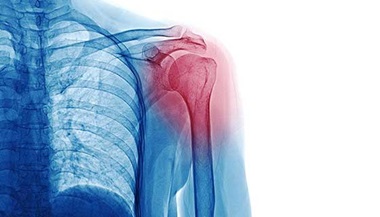Failed Rotator Cuff Repairs
Why am I still having symptoms after rotator cuff surgery?
The most common causes of pain after rotator cuff surgery are (1) that the shoulder is still recovering from the surgery itself and (2) the shoulder has gotten stiff due to lack of movement. It is well known that rotator cuff surgery is a major operation where the rotator cuff tendons (Figure 1) are sewn back to the upper arm bone (humerus) (Figures 2 and 3).
The other major reason patients have pain after rotator cuff surgery is due to stiffness of that shoulder. It is common after rotator cuff surgery to have some stiffness due to the fact that the operation caused the arm to be held without motion for some time. It is important after the surgery to protect the rotator cuff repair for several weeks while it heals, and during this time it is very common for the shoulder to get stiff to a lesser or greater degree. Your doctor and physical therapist can keep an eye on this for you and let you know if your stiffness is the expected amount or too excessive. Often times the stiffness can be treated, and the pain resolves.
It takes the repaired rotator cuff tendons about six weeks to heal initially to the bone, three months to form a relatively strong attachment to the bone, and about six to nine months before the tendon is completely healed to the bone. Most patients who have had rotator cuff surgery will tell you that it takes about nine months before the shoulder feels completely normal. This observation is supported by a study showing that in patients who have had rotator cuff surgery, strength in the shoulder muscles is not fully recovered until nine months after the surgery. As a result, it is normal to expect some continued symptoms of pain or soreness after rotator cuff surgery for several months.
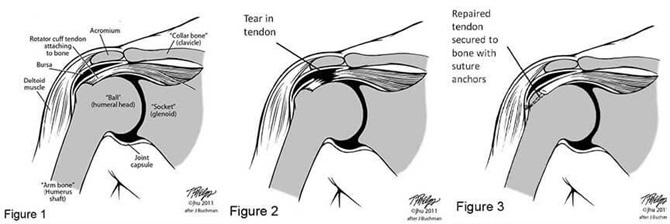
How do I treat the stiffness?
You should always follow the directions of your surgeon after surgery, since some tears need more time to heal than other tears. The best thing is to listen to your doctor as well as the physical therapist involved in your care. We tell our patients that ice is helpful for the pain, along with pain medicine of some sort, such as acetaminophen (e.g. Tylenol), anti-inflammatory medications (e.g. aspirin, ibuprofen, naproxen, etc.), pain relievers (non-narcotic or narcotic) and even prednisone by mouth (e.g. cortisone dose packs). You should take these medications only at the direction of your doctor. We usually recommend that during the first three months the emphasis in physical therapy and with your home program should be on regaining motion in your fingers, wrist, elbow and shoulder. We tell patients they have the rest of their lives to get strong, but during the first four months after rotator cuff surgery, the major goal should be largely to regain motion in the shoulder. Stiffness in the shoulder can be the cause of pain months after the surgical repair, so it is important that stiffness be addressed even months or years after the surgery.
How much therapy should I have after surgery?
Your surgeon can answer this since they are the ones who know how much work had to be done to repair the tendons. The doctors can prescribe therapy based on the work done during the operation. If more than one tendon had to be repaired or if the tendon tear is a big tear, the surgeon may recommend that the therapy progress slower to allow more time for healing; on the other hand, if the tear is small, they may allow a little more motion earlier than usual after the surgery.
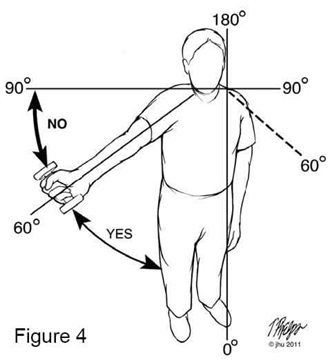
It is possible to have too much therapy, and that is usually experienced as lots of pain after the therapy session or pain for days after the therapy session. It is important that the physical therapist has a dialogue with you to make sure that the exercises are done at a proper pace for your particular surgery. We typically recommend physical therapy only twice a week. However, we recommend that patients stretch on their own the other days when they do not see the therapist. Sometimes physical therapy with the therapist three times a week is indicated, and this should be discussed with your physician and physical therapist. Similarly, it is typically not necessary to stretch more than once or at most twice a day with a home program. Lastly, if strengthening exercises are causing you pain, we recommend that you do not do the exercises over 60 degrees of elevation of the shoulder (Figure 4). This is because the rotator cuff begins to have increased stress above this level, and it can worsen the pain if the shoulder is irritated already. We recommend that you ice the shoulder after any exercise program to keep the pain under control.
What if I feel a tear or pull in therapy?
It is not uncommon to have a small "twinge" or "pull" in physical therapy, which typically does not mean that the rotator cuff repair has failed. Normally these small twinges are usually nothing to worry about. It is not really known what causes them, but it is believed that it may be scar tissue being stretched or the shoulder joint moving around normally in the socket. It would be rare for the therapy to actually cause a repaired tendon to tear, as will be discussed later.
How do I know if the tendon repair has torn again?
It is not easy to tell if the rotator cuff tendon repair has failed or not. The symptoms of pain or loss of strength are common after rotator cuff surgery while the tendons are healing, and minor setback are to be expected. We do not recommend a magnetic resonance scan or other studies when these setbacks occur for several reasons. The first reason is that magnetic resonance imaging after a surgical repair of the rotator cuff does not have the same accuracy in determining whether tendons are torn. If an MRI is performed, we recommend that it be performed with dye in the affected shoulder (arthrogram) with a needle under x-ray or CAT scan guidance by a radiologist. This test is called an arthrogram-MRI and may be positive if the tendon has not had enough time to heal or if parts of the tendon have not healed to bone. As a result, within three months after a rotator cuff repair, it is common for the dye to leak through the tendon since it has not completely healed. After this period of time, the degree of tear in the tendons can be determined best with this study.
What do I do if my tendon has not healed?
The reality of rotator cuff surgery is that while most tendons heal back to the bone after surgery, not all repaired tendons heal completely, and some do not heal at all. There are many reasons for this lack of healing with surgery. The first is that the rotator cuff tendons are large tendons which may have too extensive damage to heal. The rotator cuff tendons are big, and there are four of them. Each rotator cuff tendon is as thick as your little finger and as wide as two to three fingers. The chance that the tendons will heal with surgery is directly related to how large the tear in the tendons was before surgery. How to determine the size of the rotator cuff tendon tear will be discussed below.
The second reason that the tendons may not have healed with surgery is that these tendons begin to wear out in most humans beginning around the age of 30, and the amount of wear and tear varies from person to person for reasons we do not understand. This wear of the tendons occurs in some people but not in others. By the age of 50, many people have some wear of their rotator cuff tendons.
When rotator cuff tendons tear prior to any surgery, there are two ways they can tear. The first is that there is an injury that pulls the tendon off the bone. When this happens, there is still some tendon left to repair with very little tendon missing. However, in many cases when the tendon tears with minimal trauma, the reason the tendon tore in the first place was because it already had some tearing due to wear and tear over the years. This wear and tear over time is the second way the tendon can tear. This type of tear is best described as a tear that occurs in a way analogous to "wearing a hole in the seat of one's pants"; the tendon just gets thinner and thinner over time until there is a hole there (called an "attritional tear"). This type of rotator cuff tendon tear typically happens without the person being aware that it is happening.
The thing that is strange about this type of rotator cuff tear is that they can occur and not cause any problems until the tear gets large. These "wear a hole in your pants" tears can be any size from the size of a pinhole to "massive" tears where there is little tendon left. In these tears, the edge of the tendon at the hole is thin, and it is difficult to sew it back together. If one tries to repair a hole in the tendon that is the size of one fingernail or smaller, it is easier to repair than a larger hole. In large holes caused by this type of damage (attritional or "wear a hole in your pants" type of tear), the rotator cuff tissue around the edges is not as sturdy, and one is asking the tissue to fill up a hole where there is really no tendon. For this reason, the major factor in determining whether a rotator cuff tear can heal is how large the hole was to being with prior to the surgery. The larger the rotator cuff tear before surgery then the higher the failure rate of surgery.
How do you describe the size of tendon tears?
The first way to describe tears of the rotator cuff tendons is whether tears are part of the way through (called "partial thickness") or all the way through the tendon (called "full thickness". The tears of the rotator cuff tendons can be partial thickness (like sawing through a rope part of the way) (Figure 5) or they can progress to tears all the way through the tendon (like sawing all the way through a rope) (Figure 2). Once a tear is all the way through the tendon (called "full thickness"), the next issue to consider is the size of the hole in the tendon. As the tendons tear more, they can be of any size (depth and width).
The normal anatomy of the shoulder and rotator cuff tendons are demonstrated in Figure 6. Full thickness tears of the rotator cuff are described as small, medium, large or massive (Figures 7, 8, 9 and 10). Since most rotator cuff tendons are about as wide as three of your fingers, a small tear would be one the size of your fingernail or smaller (less than one centimeter of tendon torn) (Figure 7). A moderate size full thickness tear through the tendon would be one that is the size of three fingernails (about one centimeter in one direction and three centimeters in another). Usually tears of this size mean the whole tendon width is pulled off of the bone (Figure 8). A large tear is one that would mean the tendon is torn from the knuckle to your fingertip; this is called a large or massive tear (Figures 9 and 10). It is also possible to tear more than one tendon completely. The size of the tear is very important as it determines the chances that the tendon will heal with surgery.
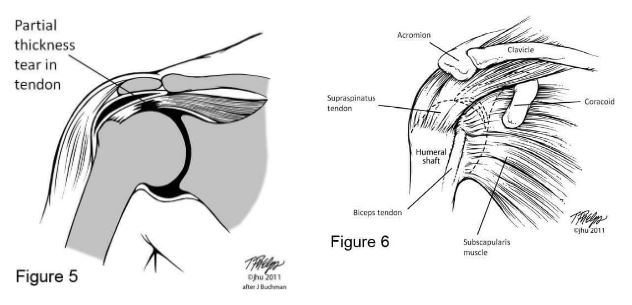
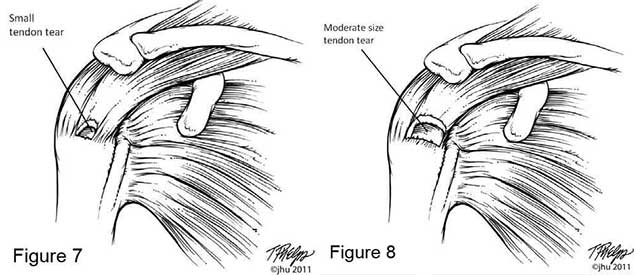
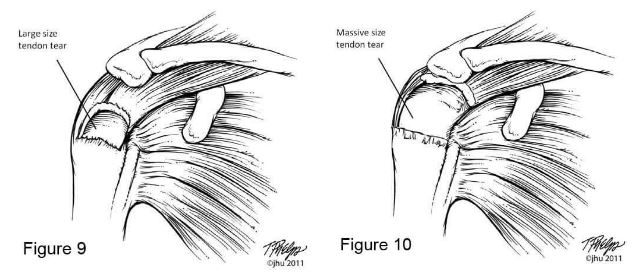
What are the chances a tear will heal with surgery?
There have been many studies that tell us approximate odds of tendons healing with surgery depend upon the size of the tendon. It has been demonstrated that small full thickness tears the size of a fingernail (one centimeter) (Figure 7) heal in a majority of cases, but approximately 5% will not heal for the reasons mentioned in the discussion above. For full thickness tears that are moderate size (one to three centimeters), the re-tear rate is around 20% (Figure 8). For large tears (three by five centimeters), the re-tear rate is approximately 27% (Figure 9). For massive tears (where one tendon is largely or completely gone or more than one tendon is torn), the re-tear rate is anywhere from 50 to 90% (Figure 10). The reason for this high failure rate with large to massive tears is because there is a hole too large to be filled by stretching the remaining tendon, and the edges of the tendon will not hold the stitches used in the repair of the tendons.
So what do I do if a rotator cuff tear fails?
Usually a tendon repair fails because it was going to fail and not because of a bad surgery or bad therapy. The reality is that rotator cuff surgery is not perfect, and not all tendons will heal completely with surgery. Once a tendon has failed an attempted surgical repair, the odds are that it will be difficult to repair again and to get it to heal. In some cases, the tear may be small enough after a failed repair to be successfully repaired, but the exact risk of failure with further surgery is related to how large the tear is at that time. The larger the tear, the less likely it can be successfully repaired a second time. In most cases a second attempt at repairing the tendon is not going to be successful unless the tear is small.
If the tendon has re-torn and cannot be repaired with further surgery, there is still hope for the function of the shoulder; the shoulder is not doomed and all is not lost. There are two myths about rotator cuff tears. One myth about rotator cuff tears is that the shoulder is doomed if the tendon is not repaired. The reality is that some people can have good range of motion and function with torn rotator cuff tendons. The degree of symptoms after a failed rotator cuff repair depends upon many factors. The typical symptoms of shoulders with un-repaired tendon tears are weakness with lifting above shoulder level or away from the body. The symptoms can often be controlled by watching one's activities, maintaining a good range of motion of the shoulder, and being careful about how much lifting one does with the shoulder. Basically one can do whatever activity he/she chooses as long as it does not hurt. We recommend that the patient lets their symptoms be their guide to activity level.
The second myth about have a rotator cuff tear that is too large to repair is that the shoulder is doomed to get arthritis or to gradually lose function. There is no way to predict what rate the shoulder will have any problems or if it will have any problems at all. There is only one study which has suggested that the shoulder with no rotator cuff tendons may develop arthritis over time. This study was not conclusive, so it is currently believed that being active does not lead to degeneration of the shoulder when there are irreparable tears. We encourage people with torn rotator cuff tendons that cannot be repaired to be as active as possible within the limits of their pain and weakness.
What about patching up the hole?
For decades there have been many attempts at finding some tissue or something manufactured to put in the hole of the torn rotator cuff tendon to help it heal. Unfortunately most of those attempts have failed as they do not regenerate or heal the hole in the rotator cuff tendons. Things that have been used unsuccessfully to patch the hole in the past include a person's own tissue (called "autografts" and include iliotibial band and biceps tendon), a cadaver or human donor tissue (called "allografts" and include iliotibial band and posterior tibialis tendons from the leg), tissue from animals (called "xenografts" and include sterilized pig-gut mucosa) and more recently patches made from culture cells (human skin cells, fibroblast scaffolds). In most instances these have no restored function and strength to the shoulder, and they should be considered experimental at this time. We do not recommend them in most instances, especially in tendon tears that have had previous surgery that has failed. Some physicians recommend these patches in tears that are very large, but the failure rate is exceedingly high. There is currently no known or proven advantage to using patches in the repair of torn rotator cuff tendons.
What about tendon transfers?
A tendon transfer is an operation where the tendon of another muscle around the shoulder is moved to replace the rotator cuff tendon. There are a couple of tendon transfers that have been described for this purpose. The first is a large muscle in the back of the shoulder called the "latissimus dorsi muscle." While this is a large muscle, the tendon is actually very thin and not very big. While this operation was once advocated for patients with large rotator cuff tears with pain, the results were not as good as initially reported. This operation is helpful for only a minority of patients and has lost favor among shoulder surgeons.
A second muscle and tendon transfer that was described once was the use of the deltoid muscle and tendon as a buffer or spacer for the space where the rotator cuff tendons were located. This operation was largely a failure and is no longer recommended.
What about shoulder replacement?
Shoulder replacements for patients with rotator cuff tears can be successful but patient eligibility continues to change and evolve. Typically shoulder replacements are reserved for patients with torn rotator cuffs who also have arthritis of the shoulder joint. The replacements are not often used for patients who have just loss of motion alone, and we tell patients that the replacements are indicated mainly for reducing pain in the shoulder. However, as there are increasing improvements in shoulder replacements, this may change and should be discussed with your doctor.
There are several kinds of shoulder replacements available for patients with arthritis and painful rotator cuff tears. Each type has its advantages and disadvantages depending on the age of the patient, the activity level of the person, and the amount of damage to the shoulder. In some instances it might be best to replace the shoulder with a more conventional shoulder replacement. A relatively new prosthesis called the reverse prosthesis has had some promise in patients with arthritis and torn rotator cuff tendons that are not repairable. These operations are generally very good for pain relief and do result in some improvements of motion. The pluses and minuses of these procedures should be discussed with your physician.
Johns Hopkins Shoulder and Elbow Surgery
Our team of orthopaedic shoulder and elbow specialists diagnoses and treats common and complex shoulder and elbow conditions, including rotator cuff tears, ulnar collateral ligament (UCL) tears, and shoulder and elbow arthritis. Our specialists are also skilled in different shoulder replacement approaches.




